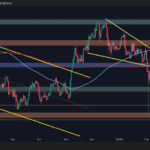Bitcoin has seen a decline in buying and selling quantity in each the spot and futures markets over the previous 5 days. The decline follows a pointy drop in Bitcoin costs every week after excessive volatility, which could possibly be pushed by a mixture of disappointing political developments, macroeconomic tensions and weekend buying and selling patterns.
CheckonChain’s information reveals an entire distinction within the magnitude of the quantity decline between the spot market and the futures market. Spot buying and selling quantity, which represents the direct shopping for and promoting of Bitcoin on centralized exchanges, fell by greater than 26%, down from $12.07 billion on March 6 to $8.93 billion on March 10.

In distinction, futures buying and selling quantity fell from $1100.95 billion to $103.48 billion. This was a 6.73% lower. The decline within the spot market surpassed the derivatives market by 19.28 share factors, growing sensitivity to market situations.

This disparity signifies the structural distinction between the 2 markets. Spot buying and selling is normally pushed by retail traders searching for direct publicity. Subsequently, the spot market responds shortly and aggressively to modifications in feelings.
In the meantime, futures buying and selling, which incorporates leveraged positions and hedges, tends to stay lively even in uncertainty, as merchants modify their positions to deduce worth actions no matter course. Between March 6 and March 10, the derivatives market confirmed extra resilience, however the spot quantity was bear the brunt of the recession.
The March 8 weekend was essential in driving a decline in total quantity, with each markets falling considerably. In contrast to conventional monetary markets, the crypto market is working repeatedly, however on weekends it constantly reveals low buying and selling exercise because of a number of components. Institutional merchants who account for growing crypto volumes usually shrink their operations outdoors regular enterprise hours, particularly on weekends when conventional markets are closed.
One of many greatest by-product exchanges, CME operates throughout regular enterprise hours. This implies many of the quantity of futures you make throughout weekday drops. Retailers additionally have a tendency to scale back their exercise because of their private schedules and perceptions that main market-run occasions are unlikely to happen.
Moreover, there aren’t any overlapping buying and selling periods within the fairness and foreign exchange markets, limiting arbitrage alternatives and additional lowering attenuation. This pure weekend slowdown creates a baseline that reduces liquidity, making the market extra vulnerable to exterior shocks.
On this case, the conventional weekend lull was amplified by sure occasions. On March 8, President Trump introduced his deliberate strategic Bitcoin spare plan. Many traders have been anticipating daring strikes to point out institutional adoption and worth hikes, together with the US authorities’s large-scale Bitcoin purchases.
As a substitute, the plan used seized Bitcoin and a “budget-neutral” acquisition technique to supply no new demand. Many Bitcoin supporters celebrated the plan, however some markets appeared disenchanted.
This disappointment sparked a cautious response, with merchants taking a ready method moderately than actively concerned. On the identical time, escalating commerce tensions between the US and China, stress was added. New tariffs on Chinese language items have heightened the worry of financial fallout and promoted risk-off sentiment that has spilled over the crypto market.
The market response was fast and clearly seen with worth motion. On March 9, Bitcoin costs fell from $86,170 to $80,640, down 6.4% in 24 hours. This volatility might have additional blocked the transaction as individuals heheed amid uncertainty.
Curiously, the quantity of derivatives rose briefly on March 8, rising from $1100.78 billion on March 7 to $11.568 billion, suggesting that some merchants used futures to hedge or capitalize the anticipated decline. Nevertheless, by March ninth, by-product volumes had fallen to $1066.6 billion, according to a wider development in decline in exercise.
Whole gross sales additionally fell 26.72%, down from $61 billion on March sixth to $4.47 billion on March tenth. This means that the worth decline was not pushed by aggressive gross sales, however moderately by lack of curiosity on purchases. When merchants retreated, there was no demand, permitting costs to slip even when the promoting stress was comparatively low.
As seen in Trump’s announcement and the fast response to commerce tensions, crypto market sensitivity stays outstanding. This reveals how totally different it’s from conventional markets the place responses are sometimes measured extra.
The sudden drop in spot quantity additionally revealed the chance of liquidity. As buying and selling exercise light, worth actions have been exaggerated – evident within the 6.4% outbreak on March ninth – poses the problem of market stability. Then again, the low quantity of derivatives means that merchants are counting on the long run to navigate uncertainty, reflecting the growing sophistication of danger administration.
Submit futures are steady, however a fall in spot Bitcoin buying and selling quantity first appeared in encryption.












